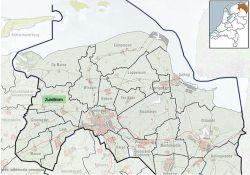
Zuidhorn, Groningen in the Netherlands
The National Aerospace Laboratory (NLR) has conducted research of low-frequency noise and vibrations in the municipality of Zuidhorn. The measurements detected low-frequency signals present at various homes, although the signals did not consistently match those of signals measured at possible source locations. These research findings were presented to the local residents on 13 October 2010.
NLR conducted this research on behalf of the Dutch Ministry of Housing, Spatial Planning and the Environment’s Inspectorate (VI), following complaints from local residents. For many years Zuidhorn municipality residents have complained of hearing low, humming sounds and vibrations in their homes and surroundings.
The noise measurements were conducted from 21 June to 5 July and focused on determining if there were low-frequency noise signals present in Zuidhorn municipality that would increase the probability of creating disturbances. Noise measurements were conducted both inside and outside four residences. Vibration measurements were conducted at one location to register any possible movements of the home. The residents also participated in the noise measurement research, keeping logbooks in which they noted the times at which (serious) low-frequency noise disturbances occurred.
The possible sources of the measured low-frequency noise signals were investigated. Because measuring equipment could not possibly be deployed at all noise-producing installations in Zuidhorn, certain areas were selected as locations to search for the presence of low-frequency noise signals. These selected areas were on the premises of two companies: NAM and the Gasunie in Grijpskerk.
Microphones were used to record low-frequency noise signals at these potential source locations. Some of these signals matched the characteristics of those measured at the homes at the same time as the residents had reported low-frequency noise disturbances.
But there were also times when the residents reported low-frequency noises disturbance, but the characteristics of those noises did not match those of the measured signals on the company premises.
Based on the conclusions drawn from the measured vibrations, it was determined that, during the measuring period, the probability of being disturbed by vibrations at the residential locations could be virtually eliminated.
These research results mark a first step in solving this problem. Based on these findings, NLR recommends the implementation of three steps in a subsequent stage. The first step is to determine which characteristics of low-frequency noise signals (such as frequencies, pulsations) are likely to cause disturbances among residents. Based on these characteristics, the search can then be focused on the accompanying, specific noise source or noise sources. When these are located, a final search for possibilities to adapt the source(s) could be undertaken, in order to reduce the probability of disturbances caused by low-frequency noise.
This research provides the clients, the State Supervision of Mines (SodM) and Ministry of Housing, Spatial Planning and the Environment’s Inspectorate, and permit issuers, such as national and regional governments and municipalities, with tools for focusing their attention on low-frequency noise.


